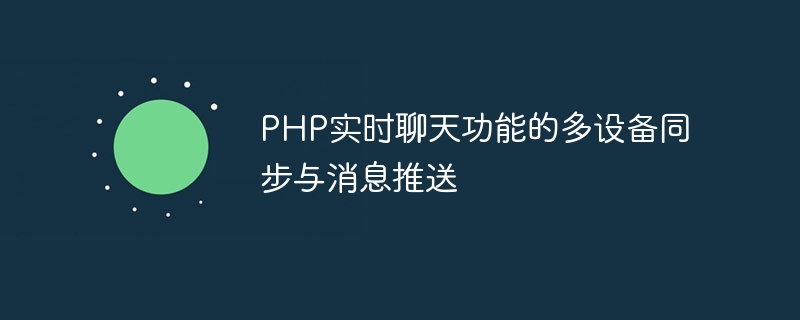Home >Backend Development >PHP Tutorial >Multi-device synchronization and message push of PHP real-time chat function
Multi-device synchronization and message push of PHP real-time chat function
- PHPzOriginal
- 2023-08-26 11:01:501692browse

Multi-device synchronization and message push of PHP real-time chat function
Introduction:
In today's era of social networks and instant messaging, real-time chat function has become One of the basic requirements of many web applications and mobile applications. When developing a real-time chat function, we not only need to implement the function of sending and receiving messages instantly, but also need to consider the issues of multi-device synchronization and message push. This article will introduce how to use PHP to implement real-time chat function and solve the needs of multi-device synchronization and message push.
1. Environment preparation
Before starting development, we need to prepare the following environment:
- PHP running environment: Make sure that the server has configured the PHP running environment and enable relevant extensions (such as Swoole extension) to support long connections and asynchronous tasks.
- Database: Choose a suitable database to store message data, such as MySQL or Redis, etc.
- Front-end interface: Develop a simple chat window for displaying chat records and sending messages.
2. Implementation process
-
Connect to the database: Use PHP to connect to the database and create a message table to store chat records.
$db = new mysqli('localhost', 'username', 'password', 'database'); $db->query("CREATE TABLE IF NOT EXISTS messages (id INT AUTO_INCREMENT PRIMARY KEY, sender VARCHAR(50), receiver VARCHAR(50), content TEXT, created_at TIMESTAMP DEFAULT CURRENT_TIMESTAMP)"); -
New message processing: Save new messages to the database through POST requests.
if ($_SERVER['REQUEST_METHOD'] == 'POST') { $sender = $_POST['sender']; $receiver = $_POST['receiver']; $content = $_POST['content']; $db->query("INSERT INTO messages (sender, receiver, content) VALUES ('$sender', '$receiver', '$content')"); echo 'Success'; } -
Chat record query: Obtain the chat record between two users through GET request.
if ($_SERVER['REQUEST_METHOD'] == 'GET') { $sender = $_GET['sender']; $receiver = $_GET['receiver']; $result = $db->query("SELECT * FROM messages WHERE (sender = '$sender' AND receiver = '$receiver') OR (sender = '$receiver' AND receiver = '$sender')"); $messages = []; while ($row = $result->fetch_assoc()) { $messages[] = $row; } echo json_encode($messages); } -
Real-time message push: Use long connections and asynchronous tasks to push new messages to all online users in real time.
$server = new swoole_websocket_server('0.0.0.0', 9501); $server->on('open', function ($server, $request) { echo "New connection: {$request->fd} "; }); $server->on('message', function ($server, $frame) { $message = json_decode($frame->data, true); // 保存到数据库 $sender = $message['sender']; $receiver = $message['receiver']; $content = $message['content']; $db->query("INSERT INTO messages (sender, receiver, content) VALUES ('$sender', '$receiver', '$content')"); // 推送给所有在线用户 $result = $db->query("SELECT fd FROM online_users"); while ($row = $result->fetch_assoc()) { $server->push($row['fd'], $frame->data); } }); $server->on('close', function ($server, $fd) { echo "Connection closed: {$fd} "; }); $server->start(); - Front-end implementation: Use technologies such as WebSocket or Long Polling to establish a long connection with the back-end and receive and send messages in real time.
3. Implementation principle of real-time multi-device synchronization and message push
- Multi-device synchronization: When each user logs in, the backend will assign him a unique identifier (such as a user ID) and bind that identity to the device's connection. When a user sends a message on a certain device, the backend saves the message to the database and pushes the message to all the user's devices through the identifier.
- Message push: Each online user's connection to the backend will be awakened and receive push messages when new messages arrive. The backend can determine which users need to push new messages by maintaining a connection list of online users.
Conclusion:
It is a common development task for PHP to realize multi-device synchronization and message push of real-time chat function. System performance and user experience can be improved through proper technology selection and asynchronous processing. The above code example gives a simple implementation idea, and developers can improve and expand it according to actual needs. Hope this article is helpful to you.
The above is the detailed content of Multi-device synchronization and message push of PHP real-time chat function. For more information, please follow other related articles on the PHP Chinese website!
Related articles
See more- Design ideas for the mall event message push function developed in PHP
- Testing and debugging skills for developing real-time chat function using PHP
- Common business scenarios and solutions for real-time chat systems based on PHP
- Emoticon package management and custom emoticon support in PHP real-time chat system
- Using PHP to realize geographical location sharing and display of real-time chat function

